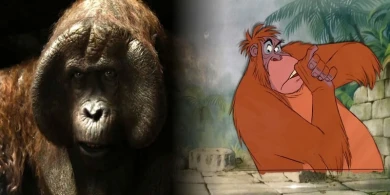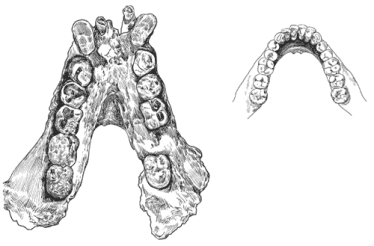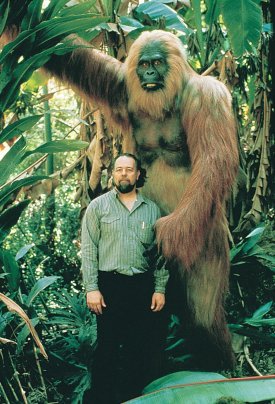James Orr
Why is the new King Louie so large?
In the recent film adaptation of “The Jungle Book” King Louie is absolutely enormous! But why did the filmmakers turn the fan-favorite jazz singing and vine swinging orangutan into a King Kong/gangster fusion?
The character of King Louie is actually a Disney creation and isn’t found in Rudyard Kipling’s original work. This makes sense; orangutans aren’t native to India. The writers wanted to remain true to the Indian fauna with the 2016 version so they used some creative paleontological thinking and changed King Louie’s species, turning him into a (magnificus) Gigantopithecus.

What was Gigantopithecus like?
Gigantopithecus is an extinct genus of great ape that lived for about 1 million years right up until 100,000 years ago. [1] There is a number of species in this genus but the most iconic (and the one that King Louie is presumably based on) is Gigantopithecus blacki. Great apes (family: Hominidae) can be divided into humans, chimps and gorillas (subfamily: Homininae) and orangutans (subfamily: Ponginae). Gigantopithecus fits in alongside the orangutans; they share a common ancestor, Sivapithecus. [2]
G. blacki was the “greatest of all great apes”. It is thought to have stood 10 feet tall and to have weighed half a tonne (500kg). It was probably too large to have been arboreal or bipedal and it is more likely that it moved around on all fours like gorillas. It was herbivorous, feeding on mainly grasses and fruit. Some researchers have postulated that it would have specialized on one extremely abundant food source. Bamboo would be the obvious choice based on the floral composition of Gigantopithecus’ habitat. [2]

What is the fossil record like?
The only Gigantopithecus fossils that have been found are a couple of mandibles and about a thousand teeth; not much to go on. The majority of these fossils were found in Chinese traditional medicine markets. They were being sold as ‘dragon bones’ (a fossil of any species is called a ‘dragon bone’ in Chinese traditional medicine) [3]. Paleontologists have extrapolated from the teeth and the mandibles to come up with an approximate head size for this extinct ape. They then use these hypothetical head sizes as well as great ape head size to body size ratios to estimate the overall size of these giants.
But was Gigantopithecus a massive ape with a proportionally sized head or was it a regular ape with an abnormally large head? Was it more like orangutans or gorillas in morphology? Or was it a strange mix of the two? Or was it something completely different altogether? No one can know for certain based on a couple of jawbones and some teeth. Let’s hope for the discovery of some more Gigantopithecus fossils! [2]

How accurate were the filmmakers?
Kudos to the filmmakers for using some cool science in order to accurately represent the Indian fauna. However, there might just be one or two problems with turning King Louie into a Gigantopithecus. The distribution of this gargantuan great ape doesn’t really fit, spatially or temporally, with Mowgli and the gang. Firstly, in all likelihood, Gigantopithecus never coexisted with modern humans (Homo sapiens). Secondly, although members of the Gigantopithecus genera did once inhabit India, the remains of G. blacki, the true giant of the great apes (and the inspiration for the new King Louie), have only been found in China and Vietnam [1]. But let’s face it, there isn’t much point in scrutinizing the zoological accuracy of a film that features talking animals and a snake with hypnotic powers.

This reconstructed model looks a bit like a King Kong/Yeti/Bigfoot? Maybe it never went extinct?! Uh oh, I’m back in the world of Cryptozoology..
Unfortunately this genus of gigantic apes went extinct about 100,000 years ago. It is hypothesized that a shift from forest to savanna, driven by climate change, changed the floral composition faster than this primate could adapt [4]. At least it lives on in film.
While Gigantopithecus was around it certainly was the “Jungle VIP”.
References
[1] Ciochon, Russel L., John Olsen, and Jamie James, 1990. Other Origins: The Search for the Giant Ape in Human Prehistory. New York: Bantam Books. Cited in: http://www.wynja.com/arch/gigantopithecus.html
[2] Ciochon, Russell L., Dolores R. Piperno, and Robert G. Thompson, 1990. Opal phytoliths found on the teeth of the extinct ape Gigantopithecus blacki: Implications for paleodietary studies. Proceedings of the National Academy of Science, 87: 8120-8124. http://www.pnas.org/content/87/20/8120.full.pdf
[3] https://theglyptodon.wordpress.com/2011/07/15/dragon-teeth-fossils-in-chinese-medicine/
[4] http://news.nationalgeographic.com/2016/01/160106-science-evolution-apes-giant/
Feature Image: http://www.livingalongsidewildlife.com/2015/09/the-biogeography-of-jungle-book-trailer.html

Wow, this piece of writing is pleasant, my sister is analyzing these kinds of things, thus I am
going to let know her.
LikeLike